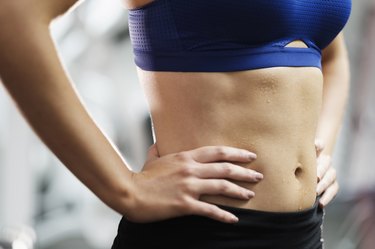
Take a look at the cover of any fitness magazine, and you're bound to see a model with enviable six-pack abs. The fitness industry flaunts toned stomachs and pitches workouts promising to get you a six pack, making you think it's the most desirable outcome of a dedicated fitness routine.
While six-pack abs are a benefit to some — especially those cover models who need to make their living posing on magazines and in calendars — they aren't a necessity to good health or core strength.
Video of the Day
Video of the Day
What Is a Six Pack?
Here's a little anatomy lesson: The front muscle of your abdomen is known as the rectus abdominus, according to Len Kravitz, writing for the University of New Mexico. It's a long, flat sheath of fibers that extend between your pubic bone and the lower ribs.
In every person, a strong tendon separates the right and left sides of the muscle and three tendon creases segment it horizontally. When you're lean enough to have these separations show, you're said to have six-pack abs.
Men with a body fat percentage of about six to nine percent and women with a body fat percentage of 16 to 19 percent usually have a visible six-pack — if they've developed their ab muscles through exercise. For some men and women, six-pack abs only become visible with an even lower body fat level.
Read more: 3 Cardinal Rules of Six-Pack Abs
Benefits of Having Abs
If you achieve six-pack abs by eating mostly whole, unprocessed foods, limiting your intake of alcohol and refined sugar and regularly exercising, your abs reflect your healthy dietary and fitness habits.
The clean diet essential to creating your abs may deter food cravings and make you feel virtuous about your eating habits. Achieving such a goal as six-pack abs can boost your confidence and make you feel proud of your appearance.
In certain sports, such as track, gymnastics or triathlon, having a low body fat percentage that shows off a six-pack is helpful because it means you have less body mass to carry as you move. In bodybuilding or figure competitions, a low body fat level and cut, six-pack abs are a must to scoring points with judges.
Six-Pack Abs and Health
Having a six pack doesn't necessarily mean you're healthier or more athletically inclined than someone with a little padding around the middle. You can easily create a strong, functional core that powers you through most sports — including a soccer match or football game — without visibly cut muscles on your middle.
A six-pack isn't an indication of more muscle; it simply means you have less fat covering those muscles. If you've attained a six-pack only by dieting to extremes and doing hanging leg raises in the gym, it isn't going to improve your performance on the field.
The body fat levels required to achieve a six pack don't provide any clear health advantage, either. Decreasing your body fat to below 14 percent as a woman or eight percent as a man shows no evidence of improved vibrancy or well-being according to the University of Pennsylvania.
Sometimes, it's just the opposite: The behavior required to dip to the body fat levels required to achieve six-pack abs can be unhealthy. You may restrict your food intake so severely that you're irritable and hungry much of the time.
Social events and restaurant meals become a struggle and much of your life revolves around a tightly-scheduled gym routine. The strict regimen and dietary restrictions can become tiresome.
A Healthy Body Fat Level
Instead of measuring your health and achievements by the abdominal muscles you see in the mirror, adopt healthy habits that make you feel energized and vibrant. The six-pack goal can be frustrating and even impossible.
Some people have muscles configured in a way that will never allow them to show off a six pack, regardless of how lean they become. The muscles are staggered, angled or the tendinous crease is so slight that only four, not six, sections are visible.
The average healthy adult man usually has a body fat of 15 to 20 percent and woman 20 to 25 percent according to the Centers for Disease Control and Prevention. Reach for lower levels if it supports your sports performance goals. Extreme measures designed to get you to achieve six-pack abs offer no benefits and may do you more harm than good.
However, losing some fat when your body fat levels at are at an unhealthy level of 25 percent or greater in a man or 32 percent or greater in a woman is prudent. Your goal doesn't have to be six-pack abs, but a healthier body overall.
Tip
Quality foods, such as lean meats, whole grains and fresh produce, and a regular exercise routine that includes cardio, strength and flexibility support good health and optimal body weight. Also, aim to get seven to nine hours of quality sleep per night.
Read more: How Long Does It Take to Get Six-Pack Abs